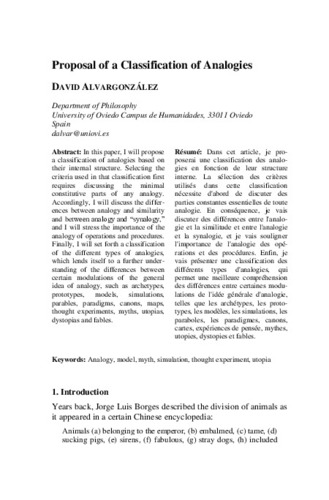Proposal of a classification of Analogies
Autor(es) y otros:
Palabra(s) clave:
Analogy
model
myth
simulation
thought experiment
utopia
Fecha de publicación:
Editorial:
Windsor Ont.: P.F. Wilkinson
Versión del editor:
Citación:
Descripción física:
Resumen:
In this paper, I will propose a classification of analogies based on their internal structure. Selecting the criteria used in that classification first requires discussing the minimal constitutive parts of any analogy. Accordingly, I will discuss the differences between analogy and similarity and between analogy and “synalogy,” and I will stress the importance of the analogy of operations and procedures. Finally, I will set forth a classification of the different types of analogies, which lends itself to a further understanding of the differences between certain modulations of the general idea of analogy, such as archetypes, prototypes, models, simulations, parables, paradigms, canons, maps, thought experiments, myths, utopias, dystopias and fables.
In this paper, I will propose a classification of analogies based on their internal structure. Selecting the criteria used in that classification first requires discussing the minimal constitutive parts of any analogy. Accordingly, I will discuss the differences between analogy and similarity and between analogy and “synalogy,” and I will stress the importance of the analogy of operations and procedures. Finally, I will set forth a classification of the different types of analogies, which lends itself to a further understanding of the differences between certain modulations of the general idea of analogy, such as archetypes, prototypes, models, simulations, parables, paradigms, canons, maps, thought experiments, myths, utopias, dystopias and fables.
Dans cet article, je pro-poserai une classification des analo-gies en fonction de leur structure interne. La sélection des critères utilisés dans cette classification nécessite d'abord de discuter des parties constantes essentielles de toute analogie. En conséquence, je vais discuter des différences entre l'analo-gie et la similitude et entre l'analogie et la synalogie, et je vais souligner l'importance de l'analogie des opé-rations et des procédures. Enfin, je vais présenter une classification des différents types d'analogies, qui permet une meilleure compréhension des différences entre certaines modu-lations de l'idée générale d'analogie, telles que les archétypes, les proto-types, les modèles, les simulations, les paraboles, les paradigmes, canons, cartes, expériences de pensée, mythes, utopies, dystopies et fables.
Dans cet article, je pro-poserai une classification des analo-gies en fonction de leur structure interne. La sélection des critères utilisés dans cette classification nécessite d'abord de discuter des parties constantes essentielles de toute analogie. En conséquence, je vais discuter des différences entre l'analo-gie et la similitude et entre l'analogie et la synalogie, et je vais souligner l'importance de l'analogie des opé-rations et des procédures. Enfin, je vais présenter une classification des différents types d'analogies, qui permet une meilleure compréhension des différences entre certaines modu-lations de l'idée générale d'analogie, telles que les archétypes, les proto-types, les modèles, les simulations, les paraboles, les paradigmes, canons, cartes, expériences de pensée, mythes, utopies, dystopies et fables.
Ficheros en el ítem




